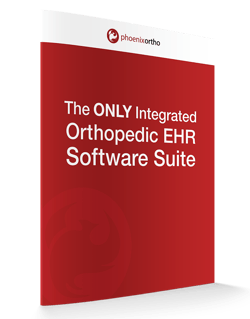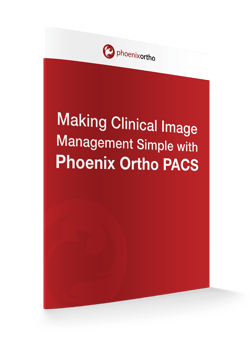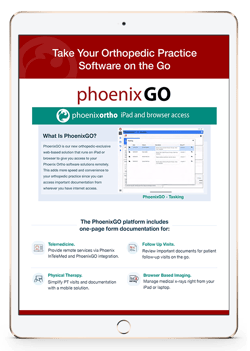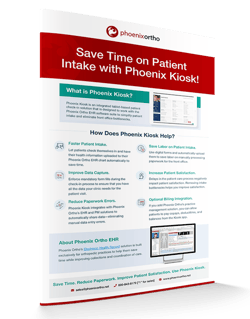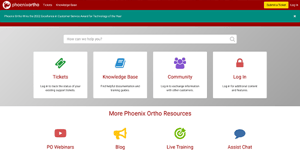Electronic Health Record systems, also known as EHR systems, have become a near-indispensable part of modern medical practices. However, using EHR in healthcare settings means handling electronic protected health information (e-PHI)—which means having to contend with the data security and privacy rules of the Health Insurance Portability and Accountability Act (HIPAA).
In this post, we will discuss what Electronic Health Record systems are, EHR compliance requirements, and why the Phoenix Ortho EHR software suite is ideal for orthopedic practices.
What Is EHR in Healthcare?
An EHR software is a solution for recording patient information—helping to organize data into the patient chart and logging treatment histories for future reference. EHRs are distinct from EMRs (Electronic Medical Records) by virtue of being more inclusive with the information they record.
Different EHR solutions will have varying capabilities. For example, some EHR software suites may have an integrated Picture Archiving and Communication System (PACS) software, while others use third-party interfaces to handle imaging requests. So, when looking for a new EHR solution, orthopedists need to verify the platform’s capabilities with the vendor prior to implementation.
HIPAA EHR Requirements
What do HIPAA and EHR implementation have to do with one another? Electronic Health Record systems store patient data electronically—which makes them subject to HIPAA’s security and privacy rules for electronically stored, processed, and transmitted data. As noted in a publication from The Office of the National Coordinator for Health Information Technology, “providers must remember that all electronic systems are vulnerable to cyber-attacks and must consider in their security efforts all of their systems and technologies that maintain ePHI.”
HIPAA EHR requirements spell out a series of administrative, technical, and physical safeguards that orthopedic practices need to implement:
- Administrative Safeguards. These protective measures cover the administrative actions, policies, and procedures that govern the use of an EHR software suite (and, more specifically, the e-PHI being processed). Some key aspects of HIPAA’s administrative safeguards include:
- Conducting periodic security risk analyses to identify potential risks so they can be addressed.
- Set policies for distributing and enforcing HIPAA security standards amongst clinic staff.
- Staff procedures for identifying potential breaches and responding to them.
- Physical Safeguards. HIPAA’s EHR compliance requirements call for clinics to protect the physical hardware that houses or runs their EHR software from illicit access. This includes ensuring that devices storing e-PHI data aren’t easily accessible.
- Technical Safeguards. Devices storing e-PHI should have reasonable technical security measures installed. This may include using antivirus/anti-malware solutions, frequently applying security patches to eliminate potential vulnerabilities, applying encryption to stored patient data, and using firewalls to isolate computers from external access attempts.
- Organizational Standards for Business Associates (BAs). When working with third parties, covered entities must “have contracts or other arrangements with BAs that will have access to the CE’s ePHI.” The goal of these agreements/contracts is to ensure that the business associate (such as a third party EHR vendor) will follow HIPAA EHR compliance requirements and protect e-PHI from being exposed to other unauthorized parties. This may require orthopedic clinics to carefully vet their EHR vendors to find ones who are certified for HIPAA compliance.
The issue that many orthopedic practices may have in meeting HIPAA EHR compliance requirements for data security and privacy is that they are not very specific. The Security Rule is vaguely worded and doesn’t often call for specific tools—instead asking for “reasonable” precautionary measures.
HIPAA’s Security Rule is vague because it is meant to be adjustable based on the resources available to the “covered entity.” Security measures that would be a minimal expense for a multibillion-dollar insurance conglomerate would be prohibitively expensive for a private practice.
Why Phoenix Ortho EHR?
Phoenix Ortho’s Electronic Health Record software suite makes meeting EHR compliance requirements easy. Phoenix Ortho EHR is a tested and certified solution—having become the first orthopedic-specific EHR to achieve a Stage 2 certification from the Drummond Group’s Electronic Health Records Office of the National Coordinator Authorized Certification Body (ONC-ACB) program*.
*Note: This does not represent an endorsement of Phoenix Ortho by the U.S. Department of Health and Human Services (HHS). It merely reflects that Phoenix Ortho’s EHR product has been certified as part of the ONC-ACB program in accordance with applicable certification criteria.
With Phoenix Ortho, you know that you’re getting a secure solution that is HIPAA-compliant. However, there’s more to Phoenix Ortho than simply complying with HIPAA EHR requirements. This EHR software suite is built exclusively for orthopedic practices, helping them to:
- Save Time. By focusing only on the forms and information that pertain to orthopedic clinics, the Phoenix Ortho EHR helps orthopedic doctors save time and mouse clicks. Instead of sifting through countless forms meant for primary care practices, orthopedists can get to the exact forms they need. This is further enhanced by the software’s ability to remember practitioner-specific preferences for every user in the orthopedic clinic.
- Eliminating Clinic Workflow Bottlenecks. Patient check-in is a classic bottleneck for orthopedic clinic workflows. Phoenix Ortho’s software suite includes Phoenix Kiosk—a patient intake solution that allows a patient to log in electronically, update their health history and make payments. Smart forms in the software help ensure that all required information is collected and that the patient’s record is updated before they ever even reach the exam room.
- Streamlining Payment Collection at the Point of Care. Phoenix Ortho, in a partnership with Secure Bill Pay, allows patients to pay their copays and outstanding balances electronically from the Phoenix Kiosk tablet application. Additionally, the EHR software suite helps log patient visit information to make Evaluation and Management (E & M) coding fast and simple so payment collection can be made at the point of care.
- Simplify Image Ordering and Management. The Phoenix Ortho software suite has an integrated Picture Archiving and Communication System (PACS). This eliminates the need to deal with a secondary vendor for the clinic’s imaging system and helps ensure that images are easy to manage between the EHR and the PACS solution since everything lives on a single database.
Learn more about how your orthopedic practice can benefit from using Phoenix Ortho’s HIPAA-compliant EHR solution by reaching out to our team today. Or, sign up for a demo of Phoenix Ortho to see the orthopedic-specific difference for yourself.
Schedule a 1:1
Get in touch with Phoenix Ortho to learn more about how you can save time, money, and mouse clicks with an orthopedic-specific EHR.





